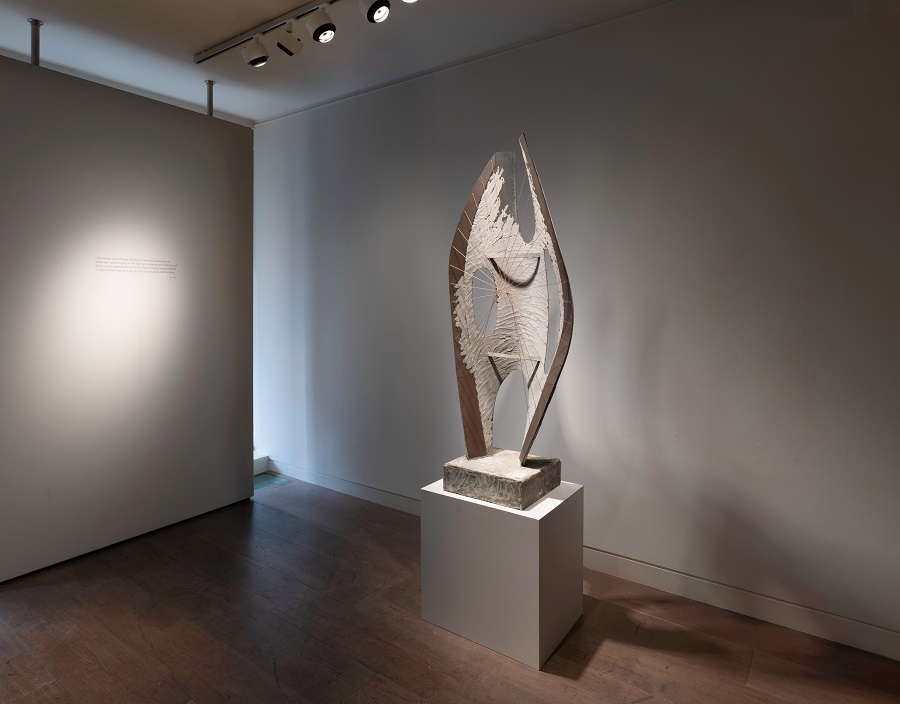
Standing proudly in its display case in the foyer of the Harold Bridges library Lancaster, walked past daily by students for the past six decades, is a large brass stringed sculpture by a very famous female British artist. Now to be seen in a unique exhibition in London, our sculpture is on show to the general public for the first time in half a century. What do you know about this intriguing artwork?
In March 1966 Dr Hugh Pollard was principal of St Martin’s College, a newly opened teacher training college, legacy institution to the University of Cumbria. This vibrant and charismatic man was very well connected and passionate about the arts, he was keen to have art on campus to inspire the staff and students.
“Hugh Pollard was highly respected by many important people and always wanted prestige for the college.” - Andrew McFadyen, student 1964-1967
When Dr Pollard found out that one of his students, David Hitchcock, lived near the artist Dame Barbara Hepworth in St Ives a plan was hatched. Pollard sent the student to ‘call on’ Dame Barbara and ask for a sculpture. The student dutifully obeyed and firstly wrote to Hepworth and arranged to meet with her. Hepworth offered the college a sculpture for the price of materials only at £1,000.
Speaking in 2014, St Martin’s College student David Hitchcock (who studied between 1964 – 1967) says:
“Sometime during my (I believe) third year at S. Martin’s Dr. Pollard approached me and, knowing that I lived in Devon at that time, asked if I would “pop down” to visit Dame Barbara and request the donation of a sculpture for the campus. The hutzpah of that action escaped me at the time, but now in retrospect, staggers me.
“The details of arranging the visit to St. Ives are lost to my memory, but I do remember the actual trip (which as an impecunious student I funded myself!) and especially Dame Barbara’s garden which was filled with many of her sculptures. I do not recall the discussion with Dame Barbara nor how I broached the request for the donation of a statue, but obviously was successful in the enterprise.”
Ultimately in 1966 the college did not have the funds to cover the cost of the sculpture but never forgot about the project. More than two years later, in June 1968 Hugh Pollard wrote again to Barbara Hepworth to state that they had raised the £1,000 and asked whether the offer would still stand. Four pieces were considered by the college, but a decision was reached on Winged Figure. The original correspondence discussing the acquisition still exists in the Tate archives today.
On 16 September 1968 Hugh Pollard wrote:
“We think it will look magnificent on one of the lawns in the centre of the college, and we hope to place it in a position where almost every student, out of necessity, will pass it daily. We are tremendously excited at the thought of its arrival.”
On 4 October 1968 art department lecturers Ben Holgate and Jan Thorn were dispatched to St Ives in the college bus.
“They are terribly excited to meet you personally and to offer you best thanks,” wrote Pollard to Hepworth.
In December 1968 Ben Holgate wrote to Barbara Hepworth to state that the sculpture was now cemented in position outside the chapel and a stone plinth had been created. He even included a small sketch of the sculpture in situ.
Ben wrote:
“The students have not taken all this lying down, but in the last issue of their magazine gave cut out diagrams and plans at how to make your own ‘Hepworth’ in paper and string. The college is very pleased indeed to have a ‘Hepworth’ of our very own.”
Watch Hugh Pollard explain the story behind our Hepworth sculpture in our '30 Years on the Hill' video from 1994.
Who is Barbara Hepworth?
Considered one of the most prominent artists of the 20th century, and arguably one of Britain’s most important female artists, Hepworth's work was at the forefront of international modern art.
Born in Wakefield Yorkshire in 1903, she studied at Leeds School of Art and the Royal College of Art in London. Winning a scholarship, Hepworth travelled in Italy studying Renaissance art. Spending time in Rome with her husband, the sculptor John Skeaping, Hepworth learnt to carve from marble. She divorced in 1933 before embarking on a relationship with the artist Ben Nicholson. Nicholson and Hepworth lived and worked together in London, exhibiting widely and setting up an artist collective Unit One. After works were destroyed in their studio during World War Two, Hepworth bought Trewyn studio in St Ives. She settled there from the end of 1950 until her death in 1975, with 2025 marking the 50th anniversary of her death.
Working with a variety of materials; wood, stone, bronze and slate, she directly carved her work using only hand tools; a hammer and chisel. Working this way enabled Hepworth to see the truth and inherent properties of the materials. She enjoyed the relaxation, the sound and movement of the process, comparing it to dancing.
Known for her abstract sculptural forms, Hepworth’s work is curvaceous, sensual and tactile, made in various sizes. She is known most notably for the use of holes and strings. Her abstract forms allow her viewers to view the art from all angles and experience their own emotion with them. Holes invite people in, allowing viewers to look through. Hepworth was interested in how the forms were experienced from different views and in different lights.

Influences
Barbara Hepworth’s father was the County Surveyor for the West Riding of Yorkshire and he would travel all over the region, often taking his daughter with him. The landscape of the Yorkshire moors, as well as the rock formations and the curves of the roads would later influence Hepworth’s work. Hepworth saw parallels between her home county of Yorkshire and her adopted home of St Ives in Cornwall. Deeply inspired by the high cliffs, granite boulders wide open moors and the sea, she fell in love with the landscapes and her natural surroundings.
Legacy
Following her death, her studio and home in St Ives became the Barbara Hepworth Museum, which came under control of the Tate in 1980.
Hepworth was awarded many national and international honours including a CBE and DBE as well as being made an honorary member of the American Academy of Arts and Letters.
In January 2015 Tate Britain staged a major retrospective with over 70 of Hepworth's works. More recently in 2023 the Heide Museum of Modern Art in Melbourne, Australia held the exhibition Barbara Hepworth: In Equilibrium.
Winged Figure
Our campus sculpture, dated 1957, stands at 57 inches tall and is made of bronze.
Entitled Winged Figure I, it is actually a maquette, or a smaller practice version, of a large prominent piece. Arguably the most famous of Hepworth’s work Winged Figure can be seen on the side of the John Lewis building in Oxford Street, London. At over 19 feet high, it was installed on 21 April 1963 and can still be seen today.
Winged Figure I is a large cut-out bronze form, roughly representing two curved wings. The right wing being slightly slimmer and taller. Each wing has two large cut outs as well as empty space at the top and bottom. Strings criss-cross the length of the piece intersecting towards the centre.

Strings
“It has strings on it, and we had it outside they all used to perish so we had to put it inside. Harry Harrison restrung it rather like a tennis racket.” said Dr Hugh Pollard, Principal, St Martin’s College
Barbara Hepworth introduced strings in her sculpture following her move to St Ives in 1950. Strings relate to mathematical models and represent space. It is also suggested that strings represent the artist’s connection with nature. Hepworth uses strings to both open up and close off the spaces in her sculptural forms.
“The strings were the tension I felt between myself and the sea, the wind or the hills” Barbara Hepworth
Strings is a new exhibition, curated by Michael Regan at Piano Nobile, a commercial art gallery in London which was established in 1985 and specialises in 20th century British art. The exhibition brings together over 20 of Barabara Hepworth’s stringed works including pieces never seen in public before. Our Winged Figure I (1957) is included alongside another similar maquette.
Curator Michael Regan said: “Hepworth is known to us today for her adventurous use of metal and rock to break down the boundaries between space and mass, giving the same value to both. Equally, as this exhibition will show, she used strings to create in her sculptures the tension between light and darkness, presence and absence, solidity and weightlessness. Most importantly, they symbolised the interconnectivity between the human figure and the landscape in a real, physical sense.”
When first purchased our campus Hepworth was placed in a prominent position outside on the grass slope in front of the Chapel. It quickly became apparent that the strings would not hold up to the harsh northern climate and they perished with the bronze becoming corroded.
In April 1974 Hugh Pollard wrote to Barbara Hepworth and declared that the piece was ‘looking rather sorry for itself’. Barbara Hepworth responded with the suggestion that it was brought back to her studio to be restored. The sculpture was then moved inside.
Winged Figure I was located upstairs in the library for many years before a refurbishment of the library took place in 2017 with funding from the Harold and Alice Bridges Charity. It enabled the sculpture to be displayed in pride of place in the library foyer to be enjoyed by staff, students and visitors.
“Ben Holgate (Art Lecturer St Martin’s College) and Harry Harrison (College Engineer) reported back that when they expressed anxiety about damage to the strings Dame Barbara was matter of fact, even dismissive, declaring “any good craftsman could repair them”. I have always thought that she meant that it was the overall artistic concept which was important.” Dr John Chippendale, St Martin’s College Doctor.
See Strings at Piano Nobile, London until 2 May 2025
Find out more here.
All images supplied with kind permission from Piano Nobile, London
